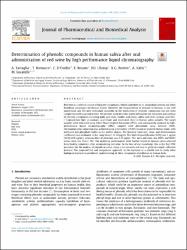| dc.description.abstract | Search ScienceDirect
Outline
Highlights
Abstract
Keywords
1. Introduction
2. Materials and methods
3. Results and discussion
4. Conclusions
Declaration of Competing Interest
Acknowledgments
Appendix A. Supplementary material
References
Show full outline
Cited By (9)
Figures (3)
Fig. 1. Schematic presentation of the analytical procedure
Fig. 2. Quantitative data obtained in saliva real samples analysis: San Clemente,…
Fig. 3. GAPI pictogram for the reported innovative procedure
Tables (2)
Table 1
Table 2
Extras (1)
Supplementary material
Elsevier
Journal of Pharmaceutical and Biomedical Analysis
Volume 209, 5 February 2022, 114486
Journal of Pharmaceutical and Biomedical Analysis
Determination of phenolic compounds in human saliva after oral administration of red wine by high performance liquid chromatography
Author links open overlay panelA. Tartaglia a, T. Romasco a, C. D’Ovidio b, E. Rosato a, H.I. Ulusoy c, K.G. Furton d, A. Kabir d, M. Locatelli a 1
Show more
Add to Mendeley
Share
Cite
https://doi.org/10.1016/j.jpba.2021.114486
Get rights and content
Highlights
•
Residual phenolic compounds analyzed in biological fluid using FPSE-HPLC-PDA.
•
Non-conventional matrices like saliva can be used for quantitative study.
•
Human saliva sample extraction using FPSE is highly selective, rapid and efficient.
•
Quantitative study using saliva presents a great potential in drug discovery.
•
Potential application of the FPSE to forensic and pharmacotoxicological studies.
Abstract
Red wine is a relevant source of bioactive compounds, which contribute to its antioxidant activity and other beneficial advantages for human health. However, the bioavailability of phenols in humans is not well understood, and the inter-individual variability in the production of phenolic compounds has not been comprehensively assessed to date. The present work describes a new method for the extraction and analysis of phenolic compounds including gallic acid (Gal), vanillic acid (Van), caffeic acid (Caf), syringic acid (Sir); (−)-epicatechin (Epi); p-coumaric acid (Cum) and resveratrol (Rsv) in human saliva samples. The target analytes were extracted using Fabric Phase Sorptive Extraction (FPSE), and subsequently analysed by high-performance liquid chromatography (HPLC) coupled with photodiode array detector (PDA). Chromatographic separation was achieved using a Symmetry C18 RP column in gradient elution mode, with methanol and phosphate buffer as the mobile phases. The linearity (intercept, slope, and determination coefficient) was evaluated in the range from 1 to 50 µg/mL. The limit of quantification (LOQ) was 1 µg/mL (LLOQ ≥0.8 µg/mL), whereas limit of detection was 0.25 µg/mL. The intra and inter–day RSD% and BIAS% values were less than± 15%. The analytical performances were further tested on human saliva collected from healthy volunteers after administering red wine. To the best of our knowledge, this is the first FPSE procedure for the analysis of phenols in saliva, using a non-invasive and easy to perform sample collection protocol. The proposed fast and inexpensive approach can be deployed as a reliable tool to study other biological matrices to proliferate understanding of these compounds distribution in human body. | tr |















